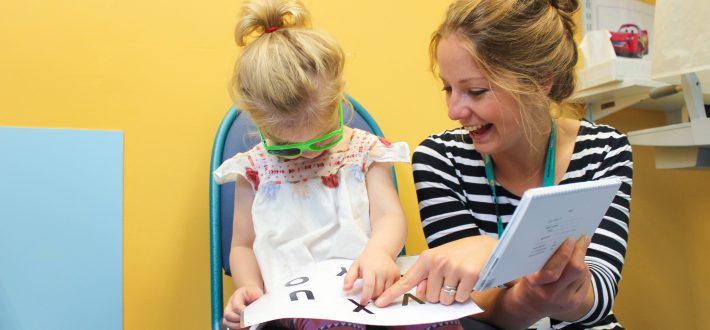- Newborn. Focuses eyes on light or face. Turns eyes and head to look at light
- 8 weeks. Follows a moving object or face with their eyes turning their head. Smiles at things or people they like
- 4 months. Reaches hands to objects. Will look at self in mirror. Watches their hands. Reaches for small objects
- 6 months. Follows objects up and down, and side to side. Likes certain colours
- 9 months. Recognises people and objects across a room. Plays peek-a-boo. Interested in pictures
- 12 months. Recognises people from a distance. Tells the difference between near and far
- 2 years. Recognises people in photographs. Likes to watch the movement of objects like wheels on a toy
- 4 years. Knows colours. Can copy shapes. Recognises the alphabet. Ready to begin reading
Vision
What your child can see is an important part of their development. It is best to pick up problems early so they can be treated, or support given to your child.
All babies are offered eye screening. In some areas children have an eye test (vision screening) soon after they start school.
Children should have an eye test every 2 years. All children can have free NHS sight tests. Children do not have to be able to read to have their eye sight checked.

- Make eye contact when you cuddle your baby
- Show your baby pictures of faces and colourful books and toys
- Point out new things to your baby
- Play peek-a-boo and hide and seek
- Read stories with them
If your child:
- Finds it hard to recognise or follow an object or person with their eyes
- Holds objects very close to their face
- Sits too close to the TV or only watches TV in the dark
- Rubs their eyes a lot
- Blinks a lot
- Fast eye movements or “wobbling” eyes
- Shows signs of a squint, for example the eyes don’t look in the same direction. One eye may turn inwards, outwards, upwards or downwards, while the other eye looks forward
- Problems finding their way in the dark e.g. entering a tunnel or the cinema
If you are worried about your child's sight or there is a history of squint or lazy eye in the family, do not wait for the vision screening at school. Take your child to an ophthalmic practitioner or optometrist, who will see children of any age.
A white or grey pupil (black part of the eye) can be a sign of other serious conditions and should be checked by a doctor straight away.
Take your child to an opthalmic practitioner or optometrist who will see children of any age.
Speak with your Health Visitor or GP early if you have any concerns about your child's vision or eyes. They can help refer your baby to have a formal eye test.
This guidance has been reviewed and adapted by healthcare professionals across West Yorkshire with consent from the Hampshire development groups.



